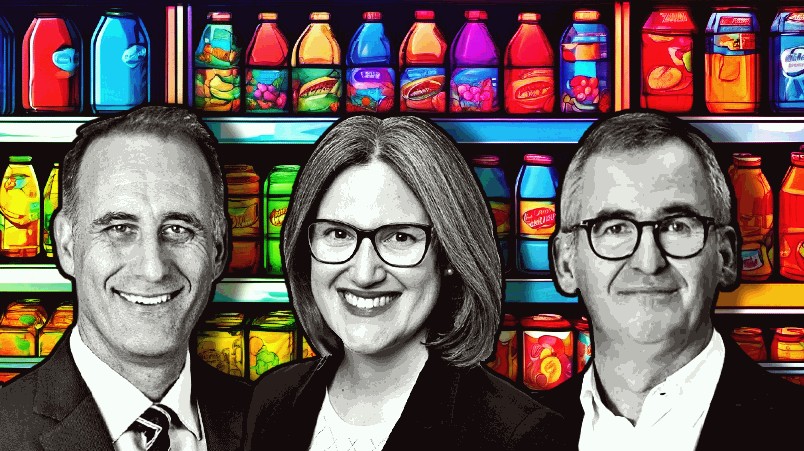Ecommerce growth rebounds at Woolies and Coles, online sales hit $1.6bn at Wesfarmers: Here's what the numbers reveal about the digital story underpinning performance at Australia's giant retail groups

Wesfarmers Rob Scott, Coles Leah Weckhert, and Woolworths Brad Banducci
A year ago, ecommerce hit the skids at Coles and Woolies as shoppers hit the streets and left the memories of lockdowns and rapacious online consumption behind. But ecommerce is back, and not just for the grocers. After years of investment, online revenues are finally starting to attain some scale at the huge Wesfarmers Group, which includes brands like Bunnings, Kmart and Target, and online marketplace Catch. The ingredients: Loyalty, retail media, and investment in distribution and in-store experiences.
We interrogate the H1 financial results for each business and read the digital tea leaves so you don't have to.
What you need to know
- A year ago, ecommerce was in sharp reversal after shoppers abandoned their keyboards, laced up their boots and went back to the high street.
- But it looks like what really happened is that ecommerce growth was simply returning to trend.
- In H1 2024, ecommerce is growing strongly again at Australia's biggest retails group including Wesfarmer brands such as Bunnings, Kmart, Target and Catch Group, plus Woolworths and Coles.
- Retail media, loyalty, in-store digital transformation and some serious bets on fulfilment centre capability are the hallmarks of digital retail growth based on these results.
We experienced strong growth in ecommerce, digital and loyalty, with ecommerce revenue growth of 29.2 per cent in supermarkets and 14. per cent in liquor, with 42 per cent growth in the Coles active users and the Flybuys active membership grew by 9.5 per cent.
Three of Australia’s biggest retail groups, Coles, Woolworths and Wesfarmers released their H1 results in the last fortnight. Together, they reveal strong ongoing investments in ecommerce, loyalty, retail media, customer experience and fulfillment.
On ecommerce, the reversal evident on last year's H1 reports has been well and truly consigned to the past, with ecommerce demonstrating rude health across both of the big grocery chains. Wesfarmers, which includes brands such as Bunnings, Kmart and Target, has also broken through the $1.5bn barrier in online sales for the half. It's a sign of the inflection point many industry pundits believed had arrived for ecommerce and the danger retailers faced if they failed to continue investing in their ecommerce capabilities.
And the value of data assets shines through, with loyalty programs central to the thinking – and operating – of all three groups.
Finally, retail media is starting to shine. Coles for instance, highlighted the momentum behind Coles 360 where media income is up 29.2 per cent, while Woolworths' Cartology division grew 14.6 per cent for the half. Wesfarmers is planning a foray via Catch with trials of a media advertising platform planned for H2.
Here are the highlights.
Coles
H1 2024 saw Coles report impressive gains across ecommerce, retail media, digital and loyalty. According to the company’s H1 report, key achievements included ecommerce revenue growth of 29.2 per cent in supermarkets and 14.9 per cent in liquor, growth in Coles App active users of 42.3 per cent, media income growth at Coles 360 of 29.2 per cent and Flybuys active membership growth of 9.5 per cent.
According to Coles Group CEO Leah Weckhert, “Our renewed strategy delivered some early wins in our immediate areas of focus, with availability metrics improving, 'Simplify and Save to Invest' benefits of approximately $90 million delivered, investments made in the customer experience through renewed stores across supermarkets and liquor, and enhancements to our ecommerce offering. We also worked at pace to take action against stock loss, with Skip Scan and Smart Gates operational in 305 and 267 stores respectively at the end of December.”
Coles financial report stated the business’s performance has been accelerated by digital. The group experienced strong uplift in Net Promoter Score (NPS), which it attributes to enhanced customer experiences including improved availability, checkout speeds, and delivery performance metrics. Strong ecommerce performance was supported by key event execution and network expansion and in particular, Coles called out how on-demand channels are driving growth in liquor ecommerce.
Weckhert described a broad uplift in ecommerce across the group, telling analysts on the earnings call "We experienced strong growth in ecommerce, digital and loyalty, with ecommerce revenue growth of 29.2 per cent in supermarkets and 14. per cent in liquor, with 42 per cent growth in the Coles active users and the Flybuys active membership grew by 9.5 per cent."
In the accompanying earnings report the company said, “Ecommerce sales increased by 29.2 per cent to $1.8 billion [33.5 per cent in the second quarter] with penetration at 9.1 per cent driven by a strong performance in seasonal events, particularly Christmas and Black Friday, improvements in availability, enhancements to the customer experience and continued network expansion," the company stated.
The company also noted that ecommerce growth was underpinned by continued strength in the on-demand channel, however, Coles noted growth in the second quarter slowed to 4.3 per cent as the business reviewed its promotional mix across channels. Coles now has rapid Click & Collect available in 621 stores, with 15 stores added in the half, while Home Delivery Rapid is now available in 487 stores (with 7 stores added in the half).
“Online NPS increased by 3.5 points with improvements across both Home Delivery and Click & Collect consistent with the enhancements in availability and customer interface,” the company stated.
What's also revealed in the report is a range of artificial intelligence and technology automation initiatives successfully implemented across customer call centres, as well as for pick optimisation initiatives, which improved efficiency.
Momentum is building with retail media play, Coles 360, with media income increasing by almost 30 per cent (29.2) during the period.
The company also reported progress on its automated distribution centre in Redbank and NSW ecommerce customer fulfillment centre.
“During the half, ramp-up was completed at the Redbank ADC with the ADC now servicing more than 200 supermarkets across Queensland and northern New South Wales and improving availability across the network. The New South Wales CFC program completed the grid build, underwent commissioning and progressed end-to-end systems and business process testing. We are working to obtain final regulatory approvals for the occupancy certificate for the incremental ramp-up to commence in line with our previously announced schedule. “
It said the Victorian CFC site has now commenced commissioning with both the grid build and rectification works having been completed ahead of schedule.
We continued to make progress on our strategic agenda through strengthening our retail platforms including advanced analytics, digital and media, ecommerce fulfillment, loyalty, and supply chain.
Woolworths
Much of the focus in the Woolworths results fell on Brad Banducci’s resignation announcement, coming just a few days after the brouhaha when the Woolworths boss was shown storming out of an interview by the Four Corners program. The two were not reportedly not related.
There was plenty of digital grist to for the mill.
Ecommerce reached $3.95bn and now accounts for 11.4 per cent of Woolworth's $34.6bn in group sales. And its share is likely to continue growing based on the relative performance of each: Ecommerce was up 17.8 per cent off what was arguably a pretty tough H1 2022, while Woolworths digital traffic grew 20.5 per cent across the group.
“We continued to make progress on our strategic agenda through strengthening our retail platforms including advanced analytics, digital and media, ecommerce fulfillment, loyalty, and supply chain," Banducci said.
On the ecommerce front, he cited strong growth driven by Australian food, with WooliesX ecommerce sales increasing by 21.3 per cent. Specifically on WooliesX, the H1 report reveals total sales increased 27.5 per cent to $4.08bn, “driven by growth across all platforms”. Woolworths also recorded DAP and EBIT increased 132.3 per cent to $168 million, which it said reflected strong sales growth and productivity improvements Margins were also up, increasing by 186 base percentage points to 4.1 per cent.
Across the group, “Customers are increasingly engaging with us through our digital and online platforms with weekly average traffic to Group digital platforms reaching 29.3 million in Q2, up 17 per cent on the prior year driven by growth in apps,” Banducci said.
Cartology, the group’s retail media play, is continuing to grow its retail media network, leveraging capabilities from the $150m Shopper acquisition through a new partnership with Vicinity Centres. This will add more than 1000 screens in over 50 centres by the end of F24.
Woolworths' H1 report indicated Cartology revenue grew by 14.6 per cent during the half, supported by strong digital advertising growth including growth in Cartology Promoted Products through sponsored search functionality. Highlights for the half included rolling out more than 400 health and beauty screens in store across Woolworths Supermarkets and the announcement of Cartology’s expanding footprint through partnerships.
Banducci also described the establishment of Woolworths MarketPlus as a key highlight during the half, saying it brought together marketplace capabilities across MyDeal, Everyday Market and BIG W into one team. BIG W Market launched ahead of Black Friday with over 20,000 products, materially extending the range for customers. To support this, BIG W launched its first stand-alone centralised ecom fulfilment solution in partnership with NP Fulfilment in Eastern Creek in Sydney.
A long-running investment in supply chain transformation also continues apace with what Banducci described as the ‘practical completion’ of Woolworth Moorebank NDC in August, two years after the physical work began. The centre is on track to be operational in H1 F25.
Loyalty program, Everyday Rewards, continued to add active members over the half, growing the golden data asset from 8.9 million in Q3 2023 to 9.4 million in the most recent quarter.
According to the report, member engagement remains strong with weekly active app users up 28.2 per cent to two million, and scan and tag rates increasing by three points on the prior year. "Customers are increasingly engage with Everyday Rewards. Everyday Extra continued to grow strongly in the half, providing members with additional benefits and more ways to save," the report stated.
Bunnings also continued to make significant progress with its digital agenda, increasing digital sales and strong customer engagement through the PowerPass and customer apps, the Bunnings marketplace and also through educational and social content.
Wesfarmers
Over at Wesfarmers, the group's One Digital loyalty play is still buried in the “Other” cells of the company’s P&L. But the business is slowly creeping towards profitability with the loss for the half falling almost 5 per cent to $39 million. Of course, that excludes the impact of Catch, according to the fine print: Catch losses exceeded those of all other OneDigital businesses combined according to the latest financial report.
Catch’s revenues fell by 37 per cent from $219m to $136m, although as a result of restructuring losses also fell, with EBITDA down from a loss of $93m last year to a loss of $27m this year. The 2022 figures included $33m in restructuring costs.
Looking ahead, Wesfarmers said it is focused on the path to profitability. That includes, “curating the in-stock range to focus on in-demand categories, accelerating growth of the marketplace, leveraging the OnePass program, and further optimising fulfilment and transport efficiencies to improve customer".
Investing in new revenue streams through ‘Fulfilled by Catch’ and a retail media strategy is about to get a big boost too, with the launch of a media advertising platform. Trials are planned for the second half of 2024. The bottom line however, is Catch is expected to remain loss-making in the second half, with losses continuing to reduce relative to 1H24.
Despite this, Wesfarmers' report makes clear there is steady progress on group-wide key digital metrics and provided historical context with four-year comparative data. Between 2019 and 2023, digital interactions increased from 94m to 210m. That translated in almost $2bn in spending over the same period off the back of an increase in digital transactions per month from half a million to 2.2 million last year.
Group online sales hit $1.6bn for the half up from $900m in H1 2020. That’s 77 per cent higher than the H1 2020 result. Wesfarmers increased its revenues overall by 49 per cent during that period. And that’s after having spent $1.9 billion in opex and capex over the four-year period.
Bunnings meanwhile is developing its nascent digital offering with digital sales. Online, app and marketplace sales now account for 5.1% of total sales, up from 4.4% of total revenues. Wesfarmers said it is continuing to invest in the in-store network, digital / tech and supply chain to enable long-term growth. It also flagged accelerated use of the OnePass, PowerPass and Flybuys loyalty programs.
According to Wesfarmers managing director Rob Scott, “Bunnings also continued to make significant progress with its digital agenda, increasing digital sales and strong customer engagement through the PowerPass and customer apps, the Bunnings marketplace and also through educational and social content."
Elsewhere in the group, discount department store Kmart is continuing to develop digital and data assets too, and the operational integration of Kmart and Target continues. The H1 report noted integration of Kmart and Target processes, systems and organisational structures to achieve one operating model across the two brands progressed in line with expectations. Furthermore, Wesfarmers said enhancing Kmart and Target’s online platforms will lead to improved delivery efficiency and improved customer experiences
There are further investments in digital supply chain and Kmart has added RFID capability in store to improve inventory accuracy. It also introduced new OnePass member benefits. Additionally, the group continued investment in customer service and digital capabilities in its Industrial and Safety division.
On OnePass, the group wide loyalty program, Wesfarmers said members continue to spend more, shop more frequently, and cross-shop at a higher rate than non-members . It added early results indicate that after joining the program, members meaningfully increase spend across Wesfarmers retailers, both in-store and online.
Clarification: In the original version of this article Bunning's online revenues were expressed in dollar terms, when they should have been expressed as a percentage of total revenue. This year Bunnings online revenues grew to $51m in the half, up from $43m in the corresponding half last year.



